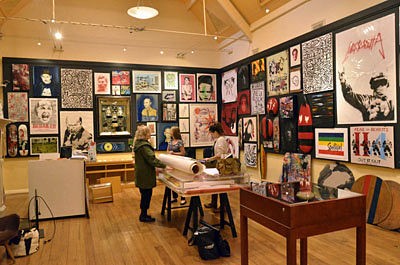What would the marketing department of the “venerable” auction house, Leonard Joel, est. 1919, say? Own a piece of outlaw history! What they did say was: ‘This sale of street art is the first time such a collection has come to public auction in Australia.’ (On view from today and on the block this Sunday 6 May.)
 That “this” is almost certainly the largest private collection of Australian street art, accrued from the earliest days since that criminalised mode/medium came out into the limelight and took over the streets. Andy Mac is, of course, Melbourne’s Godfather of Graffiti, Mayor of Hosier Lane.
That “this” is almost certainly the largest private collection of Australian street art, accrued from the earliest days since that criminalised mode/medium came out into the limelight and took over the streets. Andy Mac is, of course, Melbourne’s Godfather of Graffiti, Mayor of Hosier Lane.
The stars of the show are the three monumental friezes, Freeze Muthastika, commissioned for the Big Day Out at the Showgrounds in 2004 (items 200, 200A and 200B), the first time, Andy Mac recalls, that money had been paid for making this kind of work in a public space. Andy Mac organised, commissioned and wrangled a large unruly bunch of street artists into a public demonstration of a, then, normally clandestine activity.
At roughly 2.7m x 12 or 16m wide it would be perfect for your Versailles getaway. In any case, it will be the first time since the Big Day Out when people walked through the installation that they’ll be publicly exhibited. It’s a large as life documentation of a time when graffiti was raw art, an actual emergence. And they look fresh as the day they were sprayed.
But for the more modest of ambitions there are some very nice little classics, like Ha-Ha’s Ned Kelly and Barry, Dolk’s Starways 8, Dlux’s Lizzy, Shepard Fairey’s Obey (not the face, though), one of Marcos Davidson’s notorious Coneman figures (wrongly titled int he catalog), Paul McNeil’s excellent Cape Crusader, and a few Andy Macs as well like this. (Odd in this lot but he’s also selling a couple of period Featherstone TV chairs and a whole bunch of ceramics — Andy Mac collected ceramics? Who knew?)
Mac has put out an exhibition statement; here’re the history bits:
In 1992 I moved into a rundown building on the corner of Centre Place and Flinders Lane called Centre House. This area had been at the heart of the rag-trade in the 60s and 70s, and at the time of my arrival was in the midst of a takeover by hundreds of artists, living and working in the cheap industrial spaces made available by the economic recession of the day. There were few cafes, no bars, and lots of empty shops. Melbourne was yet to embrace its greatest urban geographical asset – the laneways. No one came to the city after 5pm. Which was great, because it made a perfect playground for the artists.
…By 2004 I had begun to initiate and curate projects like the BDO Freeze Mutherstika panels featured in this collection. This project was one of the first times that many of the key artists of the stencil art movement would collaborate together on one piece, and remains as a unique time capsule featuring artists who are today established as leaders of the field. The Freeze Muthastika Panels are a simulacra of what Hosier Lane and Centre Place looked like in 2004.
By mid 2004 Hosier Lane was painted from end to end an well on the way to becoming one of the most celebrated cultural venues in the country, attracting artists from around the world and Australia to this day. Banksy, Blek le Rat, Fafi, Shepard Fairey, and Invader are just a few of the most notorious who have left their mark here.
I might put up the rest of his statement later. In any case, the show is absolutely fascinating — as art, as history of an art movement, as history of a cultural milieu. And, it does rather feel like an era passing. Moving forwards, to the fifth generation.
Note: The Godfather gives a floor talk on the collection at 3pm Saturday 5 May.
__
Thanks to Andy Mac for his photos of the Big Day Out and the installation, which he did himself — I have to say, it’s the handsomest and most refined installation I’ve ever seen at Leonard Joel. Picture of Any Mac by myself.












Crikey is committed to hosting lively discussions. Help us keep the conversation useful, interesting and welcoming. We aim to publish comments quickly in the interest of promoting robust conversation, but we’re a small team and we deploy filters to protect against legal risk. Occasionally your comment may be held up while we review, but we’re working as fast as we can to keep the conversation rolling.
The Crikey comment section is members-only content. Please subscribe to leave a comment.
The Crikey comment section is members-only content. Please login to leave a comment.